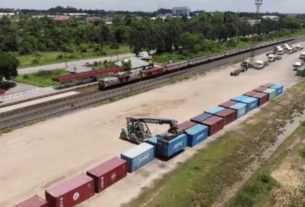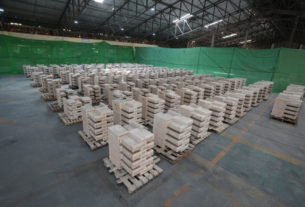
Third phase expansion of Thailand’s Laem Chabang port uncertain
17 August 2019
National oil and gas firm PTT plans to sign an agreement with the government to develop two seaports by December, but another project — the third-phase expansion of Laem Chabang port — has yet to be concluded on the state’s end.
PTT Tank Terminal Co and Gulf Energy Development formed a consortium and submitted bid envelopes for the third phases of the Laem Chabang seaport (114 billion baht) and Map Ta Phut seaport (55.4 billion baht) in the flagship Eastern Economic Corridor.
Laem Chabang seaport is in Chon Buri province. The Port Authority of Thailand announced the winning bidder on April 11. PTT and Gulf formed the consortium with China Harbour Engineering Co.
Map Ta Phut seaport is in Rayong province. The Industrial Estate Authority of Thailand announced the winning bidder in May.
Chansin Treenuchagron, president and chief executive of PTT, said the contract signing period will depend on the government’s decision.
For Laem Chabang port, the consortium plans development with an investment budget of 156 billion baht.
The project is aimed at raising capacity to 18 million twenty-foot equivalent units per year from only two phases at 11 million TEUs.
For Map Ta Phut port, another consortium plans to develop a liquefied natural gas (LNG) jetty and receiving terminal to make the port a regional hub for petroleum and petrochemical shipments.
“Both bids have been delayed for signing due to the transition to the new government,” Mr Chansin said.
He said PTT has two LNG receiving terminals in Rayong with a combined capacity of 19.5 million tonnes a year.
The 10-million-tonne receiving terminal is located adjacent to Map Ta Phut port, while another 9.5-million-tonne receiving terminal is under construction in Nong Fab of Rayong province, expecting to operate in 2022.
PTT posted first-half revenue growth of 1% to 1.12 trillion baht from the same period last year. Net profit dropped 21% to 55.25 billion baht.
Downstream business performed worse than last year as global oil and petrochemical prices sagged amid surplus supply. The revenue slowdown was offset by the upstream petroleum and power generation segments.
Mr Chansin said the average Dubai crude oil price in the second half will be in a range of US$65-68 a barrel, down from $70 in the same period last year.
“There are some negative factors, the global economy, oil pricing and widespread trade war, as well as the ongoing geopolitical conflicts and slowdown in growth for large economies,” he said.
Mr Chansin said PTT revamped its business structure over the last 6-7 years in order to mitigate the impact of high fluctuations in oil prices.
One of the plans is to diversify into electricity generation through subsidiary Global Power Synergy, which took over another peer, Glow Energy.
For the existing business units, PTT has restructured and expanded to prepare the non-oil segment for retail channels and improve quality at oil refining units.
For the petrochemical business, PTT has focused on specialty polymers and engineering plastics in order to leave out commodity-grade items, a segment that has fierce competition.
“PTT learned a lesson from the large drop in global oil prices during 2014-15 because core business units depend heavily on oil pricing movements,” Mr Chansin said.
Source: https://www.bangkokpost.com/business/1731687/third-phase-of-laem-chabang-uncertain


